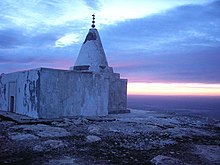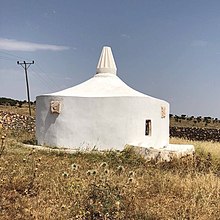List of Yazidi settlements
|
Ezidkhan | |
|
| |
| File:Ezidkhan area.jpg Yazidi settlement areas (called "Êzîdxan" by Yazidis) | |
| Language | Kurmanji (called "Êzdîkî" by Yazidis[1][2][3]) |
|---|---|
| Religion | Yazidism (called "Sharfadin" by Yazidis[1][4]) |
| Location | Upper Mesopotamia, northern Iraq (Sinjar District and the Nineveh plains in the Nineveh Governorate), northern Syria (Afrin region and parts of the Al-Hasakah Governorate), southeastern Turkey (Southeastern Anatolia Region with the Tur Abdin region inside) |
| Countries | |
| Population | 500,000 in Iraq (2018 estimation)[5] 70,000 in Syria[6][7] 60,000 in Turkey (in the 1980s)[8], today 5,000 Yazidis in Turkey[9][10] |
| Largest cities | Sinjar, Lalish |
Ezidkhan (or Êzîdxan, meaning: "Land of the Yazidis") is the name of the settlement areas of the Yazidis. The term is used for historical settlement areas of the Yazidis and also currently inhabited settlement areas by the Yazidis.
Geography
The original settlement areas of the Yazidis are located in northern Mesopotamia, today in northern Iraq, northern Syria and southeastern Turkey. The Yazidis are indigenous to this region.
Iraq
The settlement areas of the Yazidis in Iraq includes Shingal (Sinjar), Khana Sor (al-Tam’eem), Sinune (Sinuni), Zorava (al-Aroba), Gohbal (al-Andalus), Borek (al-Yarmouk), Dohula (Qadisiyah), Dugure (Hiteen), Siba Sheikh Khidir (al-Jazirah), Til Ezer (al-Qahtaniya), Gir Zerk (al-Adnaniyah), Tal Qasab (Baath), Tal Banat (al-Waleed), Hardan, Kocho etc. in the Sinjar District.[11] Shekhan (Ain Sifni), Ba'adra, Lalish, Mahad etc. in the Shekhan District and Khatare, Bozan, Beban, Babira, Dokhata, Sreshka, Khawshaba etc. in the Tel Kaif District. There are also Yazidis in Bashiqa and Bahzani in the Al-Hamdaniya District. These settlements are inhabited by Yazidis and are located in the Nineveh Governorate in northern Iraq and belongs to the disputed territories of northern Iraq. Other Yazidi villages such as Sharya and Khanke are located in the Simele District of the Dohuk Governorate.[12][13] Yazidis of the Haweri tribe live in the village of Dayrabun and in the surrounding area in the Zakho District of the Dohuk Governorate.[14] The Arabization-politic of the Ba'ath Party had destroyed many old Yazidi villages and created new Yazidi villages in the 1960s until the 1980s years in Iraq. The new Yazidi villages were mainly renamed into Arabic names.[15]

Turkey
The Yazidis in Turkey lived mainly in southeastern Anatolia, especially in the Tur Abdin region in the Yazidi villages of Taqa (Oyuklu), Kefnas (Çayırlı), Bacin (Güven), Denwan (Çörekli), Kherabya (Yenice), Koçan etc. in the Midyat District of the Mardin Province and in Efshe (Kaleli), Qolika (Değirmencik), Mezre (Çilesiz), Geliye Sora (Güneli), Khanik (Mağaracık), Fisqin (Sapanlı) etc. in the Nusaybin District of the Mardin Province and in Kiwekh (Mağara) etc. in the İdil District of the Şırnak Province.[16][17] Other Yazidi villages in Turkey are Cinerya (Yolveren) in the Batman Merkez District of the Batman Province and Hacre (Yolkonak), Feqira (Üçkuyular), Kelhok (Kuşçukuru), Qorikh (Uğurca), Shimiz (Oğuz), Hamduna (Kurukavak), Bazivan (Kumgeçit), Geduk (Deveboynu), Shahsim (Onbaşı), Dusha (Meydancık), Tekheri (Uğrak) etc. in the Beşiri District of the Batman Province.[18][19][20] There are also Yazidi villages such as Zevra (Işıklı), Burç, Oğlakçı etc. in the Viranşehir District of the Şanlıurfa Province.[8][21] Other former Yazidi settlement areas are located in the provinces of Diyarbakır and Siirt.[22] The Turkification of geographic names in Turkey renamed the Yazidi villages into Turkish names.[23] In the 1980s, there were about 60,000 Yazidis in Turkey.[8] Today there are about 5,000 Yazidis in Turkey.[9][10] Almost all the Yazidis from Turkey have fled their former villages and towns because they were oppressed and expelled by the Kurds and Turks. Most Yazidis, originally from Turkey, currently live in Germany, Armenia and Georgia. Some of them have also fled to Sinjar in Iraq. The larger cities such as Mardin, Batman, etc. are mainly inhabited by Kurds. The small Yazidi villages were mostly uninhabited after the expulsion of the Yazidis from Turkey and were considered extinct. After the mass escape of the Yazidis from Sinjar in 2014, many Yazidis from Iraq have temporarily fled to the extinct Yazidi villages in Turkey.[24][25] Some Yazidis who are originally from Turkey and currently live in Germany trying to return to their villages but they are threatened by paramilitary and islamic-fundamentalistic groups.[26]


Syria
The settlement areas of the Yazidis in Syria includes the surrounding villages around the city of Afrin, such as Basufan, Feqira, Baflun, Qastel Jindo, Shirkan, Qatma, Qibar etc. The city of Afrin itself is predominantly inhabited by Kurds. But also many Yazidis live in Afrin. About 20,000 Yazidis live in Syria in several dozen villages around the region of Afrin. An exact number of the Yazidis in Syria and their villages is unknown. Some estimates are from 21 villages, others from 23 villages and others from 26 villages of the Yazidis in the region of Afrin. The second largest settlement area of the Yazidis in Syria is located in the governorate of al-Hasakah in the region of Jazīra in northeastern Syria. Close to Tirbespi (al-Qahtaniyya) lie the Yazidi villages of Drechik, Mizgeft, Chelhumiye, Cucumber Shemo, Tell Khatun, Otelja and Alaresh. Close to Amuda lie the Yazidi villages Khirbet Khazal, Khirbet Khwe, Tell Hishk, Kulye, Merkeb, Khirbet Feqira, Qislachuk, Gondor, Kerengo, Dogerki and Chetele. North of al-Hasakah are the Yazidi villages Khirbet Khidir, Tell Tawil, Slemaniye, Tolko, Zeydiye, Berzan, Jidale, Jdeyde, Tell Teyr, Gumar, Gumar Gharbi, Tell Aswad, Mehmudiye, Antariye, Morik, Nasriye, Khirbet Jamal, Awgira , Hasheri, Mehek, Mozko, Khirbet Dilan and Bur Said. Near Sere Kaniye (Ras al-Ayn) along the Khabur River are other Yazidi villages such as Asadiye, Tell Sakhar, Tell Beydar, Merekis, Khan Temir, Shukriye, Lizga, Chava, Derdere, Tell Eliye, Abu Jarade, Tell Naif, Khirbet Batana, Tell Khanzir and Sheikh Hmud. The Yazidi villages were almost completely destroyed and bombed by the civil war in Syria and by the procedure of the Islamic State and the Turkish military operation in Afrin. Previously, IS terrorists destroyed Yazidi temples and desecrated Yazidi tombs there. Presumably, all the Yazidis fled Syria if they were not killed.[27][28]
Historical references
The term Ezidkhan is also often found in the sacred texts of the Yezidi. An example of this is the Qesîda Şerfedîn (The message of Sherfedin):[29][30]
- Ciwabê bidne Êzîdxanê (Proclaims the message in the Land of the Yezidis)
- Bila qayîmkin Îmanê (They should consolidate and defend their faith)
- Şerfedîn mîr e li dîwanê (Sherfedin is the prince in residence)
Notable historical locations
The village of Lalish, containing the holiest temple complex in Yezidism, is located within the Yezidi settlements in what is now northern Iraq.
Modern usage
Due to the formation of dedicated Yezidi Peshmerga in response to the advance of the Islamic State of Iraq and the Levant, the term 'Ezidkhan' has experienced greater usage. In October 2015 the Yekîneyên Parastina Jin ê Şengalê or YPJ-Sinjar (Women's Defense Units of Sinjar) changed its name to Yekinêyen Jinên Êzidxan or YJÊ (Ezidkhan Women's Units).[31] And in November 2015 the Hêza Parastina Şingal or HPŞ (Protection Force of Sinjar) changed its name to Hêza Parastina Êzîdxanê or HPÊ (Protection Force of Ezidkhan).[32]
See also
- Nineveh Province
- Genocide of Yazidis by ISIL
- Sinjar massacre
- Sinjar Alliance
- Kurdification and Arabization
- Yazidi language
References
- ^ a b Asatrian, Garnik S.; Arakelova, Victoria (2014-09-03). The Religion of the Peacock Angel: The Yezidis and Their Spirit World. Routledge. ISBN 9781317544289.
- ^ Nielsen, Jørgen; Akgönül, Samim; Alibašić, Ahmet; Goddard, Hugh; Maréchal, Brigitte (2011-10-28). Yearbook of Muslims in Europe. BRILL. ISBN 9789004207554.
- ^ Coene, Frederik (2009-10-16). The Caucasus - An Introduction. Routledge. ISBN 9781135203023.
- ^ Arakelova, Victoria. "Ethno-Religious Communities Identity markers".
{{cite journal}}: Cite journal requires|journal=(help) - ^ "Surviving Islamic State: The Plight Of The Yazidi Community". Nikita Malik. Forbes. Retrieved 13 January 2019.
- ^ "Yazidi in Syria Between acceptance and marginalization" (PDF). KurdWatch. kurdwatch.org. p. 4. Retrieved 1 April 2014.
- ^ Andrea Glioti (18 October 2013). "Yazidis Benefit From Kurdish Gains in Northeast Syria". al-monitor. Archived from the original on 19 February 2014. Retrieved 1 April 2014.
{{cite news}}: Unknown parameter|dead-url=ignored (|url-status=suggested) (help) - ^ a b c Açikyildiz, Birgül (2014-12-23). The Yezidis: The History of a Community, Culture and Religion. I.B.Tauris. ISBN 9780857720610.
- ^ a b "Turkey". U.S. Department of State. Retrieved 2019-01-22.
- ^ a b International Religious Freedom (2010): Annual Report to Congress. DIANE Publishing. ISBN 9781437944396.
- ^ "Emerging Land Tenure Issues among Displaced Yazidis from Sinjar, Iraq" (PDF). United Nations Human Settlements Programme (UN–Habitat). November 2015. Retrieved 2018-12-06.
{{cite web}}: Cite has empty unknown parameter:|dead-url=(help) - ^ Saadi Azuo, Heerish (June 2016). "Graduate school of social sciences general psychology master's programme: Post-traumatic stress disorder among Ezidian women who escaped from ISIS capture" (PDF). Near East University. Retrieved 2018-12-06.
{{cite web}}: Cite has empty unknown parameter:|dead-url=(help) - ^ "The Struggle to Exist - Part I: An Introduction to the Assyrians and their Human Rights Situation in the New Iraq" (PDF). Assyria Council of Europe, Hammurabi Human Rights Organization. February 2010. Retrieved 2018-12-06.
{{cite web}}: Cite has empty unknown parameter:|dead-url=(help) - ^ Oehring, Otmar. "CHRISTIANS AND YAZIDIS IN IRAQ: CURRENT SITUATION AND PROSPECTS" (PDF). Konrad-Adenauer-Stiftung. p. 93. Retrieved 2019-02-19.
{{cite web}}: Cite has empty unknown parameter:|dead-url=(help) - ^ Dulz, Irene (2001). Die Yeziden im Irak: zwischen "Modelldorf" und Flucht (in German). LIT Verlag Münster. ISBN 9783825857042.
- ^ "TMMOB Mimarlar Odası Diyarbakır Şubesi" (PDF). Retrieved 2018-12-29.
{{cite web}}: Cite has empty unknown parameter:|dead-url=(help) - ^ "İHD'den Ezidi Raporu". Mardin Life Gazete, Dergi, Ajans ve Matbaası (in Turkish). Retrieved 2019-01-03.
- ^ Soydan, Ersoy. "BATMAN YEZIDIS AND YEZIDIS ORAL TRADITION (BATMAN YEZİDİLERİ VE YEZİDİ SÖZLÜ KÜLTÜRÜ)".
{{cite journal}}: Cite journal requires|journal=(help) - ^ "ON FINAL SETTLEMENT PLACES AND POPULATION OF EZIDIS, AN ETHNO-RELIGIOUS COMMUNITY, IN BATMAN AND NEARBY VICINITY" (PDF). Turkish Studies. Retrieved 2018-12-29.
{{cite web}}: Cite has empty unknown parameter:|dead-url=(help) - ^ "İNSAN HAKLARI BATMAN PLATFORMUNUN BATMAN'DAKİ SIĞINMACI VE MÜLTECİLERE İLİŞKİN GÖZLEM VE TESPİT RAPORU" (PDF). Retrieved 2019-01-03.
{{cite web}}: Cite has empty unknown parameter:|dead-url=(help) - ^ AYDIN, Gülden. "Son 377 Yezidi kaldı". www.hurriyet.com.tr (in Turkish). Retrieved 2019-01-03.
- ^ Acikyildiz, Birgul (2014-08-20). The Yezidis: The History of a Community, Culture and Religion. I.B.Tauris. ISBN 9781784532161.
- ^ "Yazidis in Turkey on the verge of extinction". Israel National News. Retrieved 2019-02-02.
- ^ "Genetic Affinity between the Armenian Yezidis and the Iraqi Kurds" (PDF). Retrieved 2018-12-29.
{{cite web}}: Cite has empty unknown parameter:|dead-url=(help) - ^ "Yazidis in Turkey: Old homeland, new homeland - Qantara.de". Qantara.de - Dialogue with the Islamic World. Retrieved 2019-01-03.
- ^ "Situation von Angehörigen der ezidischen Religionsgemeinschaft" (PDF). bundestag.de (in German). Deutscher Bundestag. 2014. p. 2. Retrieved 2019-02-12.
{{cite web}}: Cite has empty unknown parameter:|dead-url=(help) - ^ Maisel, Sebastian (2016-12-24). Yezidis in Syria: Identity Building among a Double Minority. Lexington Books. ISBN 9780739177754.
- ^ Mercadier, Sylvain. "Turkey's Afrin operation stokes Yazidi fears and fuels displacement". alaraby. Retrieved 2018-12-29.
- ^ "ÊzîdîLeaks: Sheikh Sherfedin und seine militärischen Aktivitäten". Retrieved 16 January 2016.
- ^ "Qesîda Şerfedîn – Die Botschaft Şerfedîns". Retrieved 16 January 2016.
- ^ "ANF - Ajansa Nûçeyan a Firatê". Retrieved 16 January 2016.
- ^ "HPŞ benennt sich in HPÊ um: Hêza Parastina Êzîdxan – ÊzîdîPress". Retrieved 16 January 2016.

